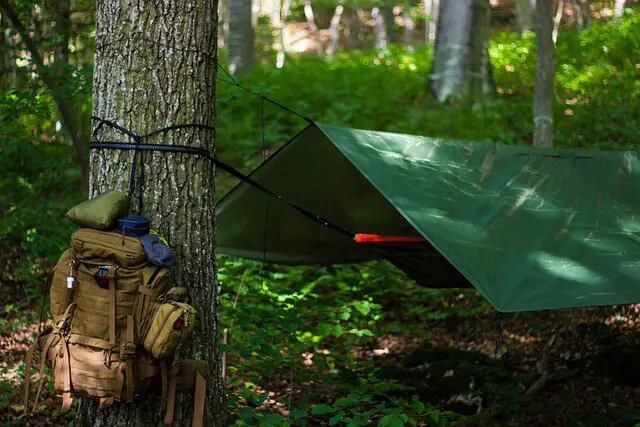There’s nothing like multiple days of rain to put a dampener on your week, especially when you’re camping.
If you know you’re in for a bought of bad weather when you’re planning a camping trip, a tarp is an inexpensive way to shelter from the rain and in turn, keep your tent dry.

Table of Contents
Why To Use Tarp Over a Tent?
Using a tarp can provide you and your family with some relief from the elements and harsh weather conditions, especially when it comes to cooking outside and keeping your possessions dry.
However, people unfamiliar with camping gear might be wondering: how do you put a tarp over a tent? Don’t worry, we’ve got the answer for you.
In this article, we explore the useful purposes of a tarp, how to put a tart over a tent to make a shelter from the rain, and much more.
How to put a tarp over a tent? - Few Different Ways
There are a few different ways to put a tarp over a tent. The location of trees or other supports such as poles, the shape of your tent, and the wind direction will influence the choice of shape you opt for.
Building a basic shelter is easy enough, all you’ll need to use is two trees or two straight tent poles, pegs, rope, and a tarp.
The simplest tarp shelter, also known as the A-frame shelter, is created by creating a taut guyline between objects over your tent.
Guyline tension, tarp height, and properly placed driplines are fundamental for your tarp shelter to work. So let’s begin!

Precautions to take before setting up your tarp
Before you start, you should make sure that:
- You pick a spot that has some good trees that are far enough away from each other so you can create your ridgeline on them.
- Check above you to ensure that there are no dead trees (also known as windowmakers) above you.
- Choose a flat patch of grass that has a slight slope so the water that collects on the ground will flow away from your site.
- Make sure that you’ve cleared the area from any debris or dead branches for a more comfortable sleep! After all, you don’t want anything to damage the tent or be sticking in your back as you sleep.
From my experience, I can suggest a tarp from manufacturer Unigear because this product is not expensive, have UV Protection and PU 3000mm Waterproof, is Lightweight for Camping, Backpacking, and Outdoor Adventures.
- STAY DRY IN THE RAIN: Unigear tent tarp is made of super strong 210D rip-stop Oxford fabric, PU 3000mm waterproof. It offers an excellent protection against rain, sudden downpours, snow and high...
- NO MORE RIPPING & LEAKING: To offer a safer and tougher shelter, all the 8 fix points on the rain fly are reinforced a triangle dual layer. Besides, all fix points are used double reinforced stitches,...
- BLOCK THE SUN: Coated with PU Inner layer, Unigear lightweight tarp can provide a UV protection in the sun. Perfects for hammock camping, backpacking, hiking, or other adventure.
So why should you pack a tarp?
Handy uses for a tarp
Not only are tarps designed to keep you dry, but they also have a plethora of uses that make them an incredibly versatile piece of equipment everyone should have at their disposal.
- A tarp allows you shelter on a number of occasions, namely when you’re outside cooking, when it’s raining, and when you’re eating.
- You can use a tarp as an impromptu shelter when you’re first putting your tent up in the rain.
- If the ground is particularly wet when you set up your tent, you can use the tarp as a groundsheet as an extra layer of protection to keep you and the bottom of your tent dry.
- You can use a tarp to enjoy a campfire when it’s wet, as you won’t struggle to light it if you have shelter and a couple of windbreaks. The tarp will provide some respite from the rain!
How to build a shelter over your tent with a tarp
- To create the ridgeline, wrap your cordage around a nearby tree, pole, or any other structure that is secure and find another nearby structure to tie the other end. Make sure that you tie the cordage higher than you think it needs to be, but you can always adjust this as needed later.
- Lay your tarp on top of the ridgeline and spread it out as much as you can.
- Stake down the 4 corners of the tarp through the holes provided with your guylines. Make sure to do this fairly taut so that rain can flow away from the tent effectively.
When putting a tarp over a tent, you should be mindful to consider how rain will fall from the tarp you just constructed as this will affect the durability of your tarp and how well it will work.
You might find this has a lot do to with trial and error, but it can be easy to misjudge the tautness of guylines, so make sure you take this into account when setting up your tarp.
You could always try chucking some water over your tent in order to check its durability and to see whether it will hold up under heavy rainfall.
After setting up your tarp
As we’ve mentioned, driplines are essential for the success of your tarp. That being said, after you set up your tarp you need to create a dripline on your ridgeline.
Simply put, the dripline is a piece of rope on the ridgeline on the outside of the tarp that diverts the water collected on the ridgeline when there is rainfall.
Make sure that you tie this dripline on both sides of the ridgeline a few inches from the tarp and you’re good to go!
Bowline knot
If you’re a regular camper, then it is likely that you’ve got a few useful knots in your memory. If you don’t, this is a simple one to remember and can be used when you’re making your ridgeline.
- Lay the rope across your left hand with the free end hanging down. Form a small loop with the line.
- Bring the free end up to and pass through the eye from the underside.
- Wrap the line around the standing line and back down through the loop.
- Tighten the knot by pulling on the free end while holding the standing line.
In summary
A tarp is an incredibly useful and versatile piece of equipment that you should have at your disposal when you’re planning a camping trip away. There are an array of different uses and benefits of using a tarp.
Not only can they keep wet weather conditions at bay, but they also provide you some relief when it comes to cooking outside in the rain.
You don’t need to spend a lot of money to remain dry throughout your trip, but if your tent fails, you’ll want another backup that can lift you and your family’s spirits.
Have a happier camping experience all around, and be prepared for every eventuality with a tarp in your possession!
- Are Merrell Shoes Good? – An Unbiased Review of Merrell Footwear - December 9, 2023
- Where Are Merrell Shoes Made? - December 9, 2023
- Camping in 40-degree Weather: Tips and Tricks - September 25, 2023



![How to Store Cast Iron for Camping? [Tips & Tricks] How to Store Cast Iron for Camping? [Tips & Tricks]](https://grandcircletrails.com/wp-content/uploads/2022/05/How-to-Store-Cast-Iron-for-Camping-150x150.jpg)

![How to Store Eggs for Camping? [Useful Tips] How to Store Eggs for Camping? [Useful Tips]](https://grandcircletrails.com/wp-content/uploads/2022/05/How-to-Store-Eggs-for-Camping-150x150.jpg)

![How to Stay Warm Sleeping in a Car? [Detailed Guide & Tips] How to Stay Warm Sleeping in a Car? [Detailed Guide & Tips]](https://grandcircletrails.com/wp-content/uploads/2021/10/How-to-Stay-Warm-Sleeping-in-a-Car-1-150x150.jpg)